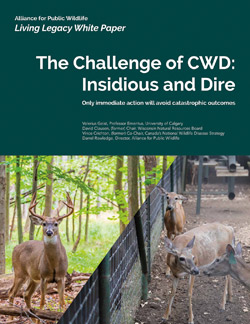|
 |
Chronic wasting disease (CWD) continues to spread across Alberta and other jurisdictions. To date, CWD has been found in 24 US states, 3 Canadian Provinces, as well as in South Korea and more recently in Norway.
In Alberta, Dr. Margo Pybus and her team continue to test the heads of hunter-killed deer and elk, and continue to find cases of infected animals. Most recently, a hunter-killed elk from Canadian Forces Base Suffield, where more than 8000 elk are thought to reside.
 |
As of February 17 of this year, Dr. Pybus and her team “have tested over 4200 heads of deer and elk since September 1, 2016, and have detected CWD in 135 deer (115 mule deer, 19 white-tailed deer, 1 unknown deer; 99 males, 35 females, 1 unknown gender) and 1 male elk.”
Her final 2016 CWD surveillance report should be available in early April, with numbers expected to be higher than the 136 animals already discovered with CWD.
Meanwhile, The Alliance for Public Wildlife has been hard at work distributing a white paper that “examines the science behind the disease, the history and process of its spread, and the public policy implications and recommendations for dealing with it.”
The brainchild of Alberta’s Darrel Rowledge, The Alliance for Public Wildlife (APW) is “dedicated to establishing, developing, promoting, and defending principles and policies that will ensure the conservation of North American wildlife.”
The white paper (pictured at left) can be downloaded from the APW website at http://apwildlife.org/publications.
According to paper, “Left unchecked, the prospects for wildlife are bleak. CWD has clear population impacts; some models suggest extinction. CWD is now deemed to be the largest-ever mass of infectious prions in global history, and experts sum up the threat (to wildlife, agriculture, our economies, and potentially to human health) in two words: insidious and dire.”
The paper discusses much about CWD, including its possible zoonotic capabilities (jumping to humans) and the fact that “the infective agent is taken up via the root systems of plants growing in contaminated soils.” Which clearly could spell disaster for agriculture... and the condemnation of our deer and elk herds should they be considered “infected vermin, shedding prions into landscapes and into agricultural lands and crops.”
Over at the U of A Department of Biological Sciences, Dr. Debbie McKenzie and her team are moving forward after being awarded $11.5 million for a genetic study focusing on chronic wasting disease. In a recent email, Dr. McKenzie advised, “We are taking a multi-pronged approach to developing both ante-mortem and rapid post-mortem tests of deer and elk (and caribou). We are in the preliminary phases of collecting samples (both tissue samples as well as body fluids) from infected and uninfected animals and will be analyzing these samples using a number of different methods to identify markers of CWD infection.
“Our goal is the development of tests that would allow samples to be collected in the field and then assayed either in the field or, most likely, by validated testing facilities.
“With respect to harvested deer, we would like to generate a test that doesn’t require shipping of heads for testing; ideally, a hunter could take a blood sample or a small tissue sample and submit it for testing. For live deer and elk, a means of detecting CWD in animals that don’t appear infected would be advantageous, facilitating movement of animals between farms etc.
“A second test is also being developed to enable us to detect CWD in the environment. Infected deer and elk shed CWD in their feces, urine and saliva. The carcasses of dead, infected deer would also result in environmental contamination. A long-term issue is the identification of CWD in the environment. Current methods of decontamination are not efficient, either in terms of decontaminating or cost, in areas where CWD is endemic in free-ranging animals. We are looking to develop methods for detection of CWD in soil, as well as in fecal material from cervids.”
Described as “one of the most outrageous human susceptibility experiments in history,” an estimated 7,000 to 15,000 CWD-infected animals are being consumed by hunters and their families each year.
Insidious and dire... indeed! ■
For previous Outdoor Pursuits click here.
|
|
|
|


